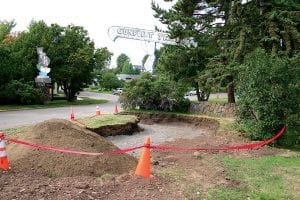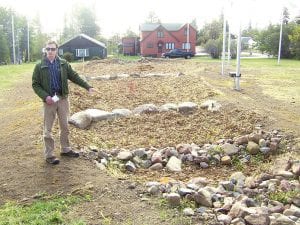Staff photos/Jane Howard On Thursday, October 1, 2009, Cook County Soil & Water Conservation Technician Tristan Beaster gave the Soil & Water Board a tour of the new rain garden outside the courthouse in Grand Marais. Above: Another rain garden project in progress in front of the Grand Marais Library.

A rain garden is more complex than some people might think it would be. On Thursday, October 1, 2009, Cook County Soil & Water Conservation Technician Tristan Beaster gave the Soil & Water board a tour of the new project south of the courthouse parking lot and explained how it works.
A description of the tour said, “The rain garden will be used to provide public education about the need to remove pollutants from storm water and regulate the ‘gush’ of storm water off pavement during rains.
“The rain garden’s 18 inches of biosoil and deep-rooted plants will break down and digest oils draining off the courthouse parking lot and hold rainwater for 24 to 48 hours, allowing it to gradually absorb. It is not a pond.”
The rain garden was constructed to keep salts and pollutants from ending up in Lake Superior. It could have been bigger, Beaster said, but they made the footprint as small as possible while still being able to handle all the runoff from the parking lot.
The rain garden is one of three similar projects in Grand Marais. A rain garden behind the 4-H building on Community Center grounds was completed in the early summer, and one on the Grand Marais Library grounds is under construction.
At the courthouse rain garden, a series of steps separated by boulders and rocks was built into the garden. The first step, filled with rocks, was designed to catch sediment from the parking lot. Thenext step, which will fill with water, will capture the energy from the water flowing off the parking lot. Different plants will be used in each section depending on their tolerance for water. All the plants are native to Minnesota, most of them native to Cook County. By next summer, about 1,000 plants will have been planted in the garden.
After a rainfall, the garden will have standing water no longer than 48 hours, Beaster said. He believes it may be able to handle up to two inches of rain in a 24-hour period, twice the amount it was designed to handle.
How much maintenance will the garden require? It will require weeding, Beaster said, although once the plants are established, less weeding will be required. In the future, accumulated sediment will need to be removed. Overall, however, Beaster said, the vegetation will require less maintenance than mowing a lawn.
Within a week after being planted, about 1-1½ inches of grass had already sprouted around the edges of the garden.
Theproject was planned in 2007, and 75% of the $15,264 cost was paid for by the state. Three percent of the cost of the project was covered by volunteer labor.
“We’re impressed,” Soil & Water board member Joan Farnam said. “We’re very impressed.”



Loading Comments